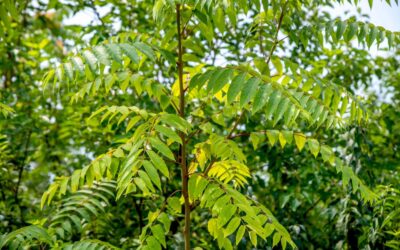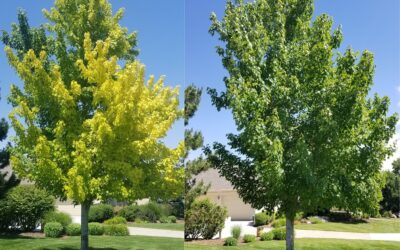If you’re one of the many who can’t wait for the end of summer when the Palisade peaches reach the markets from Western Slope orchards, you know that peach trees play an important role in the Colorado economy. They’re also great landscape trees with their beautiful spring blossoms, long, attractive leaves, and graceful, trainable limbs.
Origin and Varieties
Peaches are native to northwest China and reached the U.S. through Persia and southern Europe. With roughly 8,000 years of cultivation, China remains the world’s largest producer of peaches. There are hundreds of varieties of peach, including nectarines, which are the same species, although regarded differently commercially. The difference between the two fruits is their skin—one fuzzy and the other smooth—and seems to be the result of a single gene.
Size, Flowers and Fruit
Peach trees can range from barely over 12 feet tall in dwarf varieties to over 30 feet high standard trees. Their branches are flexible enough to be trained to espalier on south-facing stone or brick walls that absorb solar heat and release it slowly, extending the growing season in colder climates.
Spring flowers are a showy pink and develop into fruits with either white or yellow flesh. The flowers are a good source of pollen for honey bees and honeydew for aphids. Yellow-flesh peaches are more acidic and are the preferred variety in North America and Europe. The seed-bearing pits are classified as either freestone or cling, depending on how firmly the flesh holds onto the stone. As delicious a fruit as they are, peaches contain a relatively low nutrient value. For instance, a 3.5 ounce serving has only 8% of the recommended daily intake of Vitamin C.
Ideal Growing Conditions and Climate
Peaches grow best in drier temperate climates, requiring chilling to initiate needed chemical processes followed by warmth to begin budding. Then summer temperatures allow the fruit to develop and ripen. While the trees themselves can withstand temperatures well below zero, a major challenge to growing peaches in Colorado is our tendency to have warm periods before late spring frosts that can kill early blossoms, greatly reducing or even eliminating fruiting.
Planting, Watering and Pest Prevention
Plant peach trees in early winter and wrap young trunks to prevent sun scald. Plant in full sun with well-drained soil and good air circulation, and avoid low spots where late frosts can damage the blossoms. Thinning the blossoms mid-season will increase the size and sweetness of the fruit. Peaches need a regular supply of water and nitrogen-rich fertilizer to avoid stunted growth and leaf drop. Pests include earwigs, leaf rollers, peach twig borers and peach tree borers and can be prevented with proper application of permethrin. Application of insecticides should be stopped at least 20 days before harvesting the fruit to avoid residue. Typical peach cultivars need three years to begin bearing fruit.
If you’re considering planting peach trees or other landscape trees and shrubs, or have ones that need maintenance, Donovan Arborists offers planting, pruning, and shearing services in the Denver area. We’re happy to give free estimates to homeowners and property managers for any services you may need.



